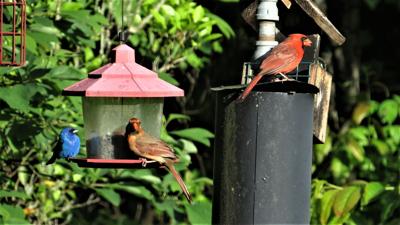Nature News | Marlene A. Condon Nov 5, 2021

White millet and sunflower seeds are really all you need for a bird-feeding program, but you must offer these two kinds of seeds separately in the proper types of feeders.
Two varieties of millet (also referred to as proso millet) are often put into seed mixtures: white and red. Red millet is not eaten much by birds in the eastern part of the United States (birds in the West do have different preferences), which is why it’s best to purchase white millet individually packaged. Serve it to ground-feeding birds either in a tray feeder or directly on the ground (but not where cats are around, please, and only put out as much as will be taken by birds that day).
There are also two varieties of sunflower seeds: black oil and striped. Black oil is smaller and might be easier for some birds to eat. Its high oil content provides lots of energy. Striped sunflower seed is larger but has less oil content. Birds with beaks capable of cracking the shell will readily eat this seed, but it is not nearly so popular as black oil.
You can offer the striped, especially if it is less expensive and you want to save money, but black oil is the superior seed. You might see what are called “blended” sunflower seed mixtures consisting of both kinds of sunflower seeds, and if the price is right, you could buy such a mix.
Some species of birds (such as Carolina Wrens) do not have beaks capable of breaking open sunflower seed shells. Such birds can only eat sunflower seeds which are already cracked enough for them to be able to pry the shell off or sunflower seeds already hulled (stores that sell these refer to them as sunflower chips, pieces, or hearts).
Hulled sunflower seeds are attractive to virtually all species of birds, even those that eat white millet (although Brown-headed Cowbirds are unusual in that they seem to prefer the millet). These seeds are more expensive per pound, but you are paying only for edible food, and not for inedible shells. I highly recommend them for feeding areas where you do not want shell litter under the feeder or numerous sunflower seedlings when spring arrives.
Other kinds of seeds are attractive to birds, but may be more expensive, such as niger (or nyger, from Nigeria and pronounced NYE-jerr). It’s very enticing to American Goldfinches, Mourning Doves, and Pine Siskins. You might think of niger as a special treat that you do not need to put out all the time.
Most folks buy a nyger feeder with tiny holes that is especially made to dispense these seeds that are very thin. I have found, however, that any tube feeder will work. What looks like fallen seeds below the feeder are, upon close inspection, simply the discarded shells. The birds do not swallow the entire seed but instead crack it open to eat what’s inside.
For a much closer view of birds, try feeding them.
